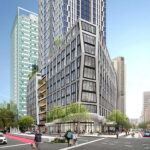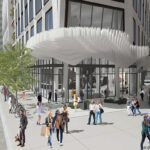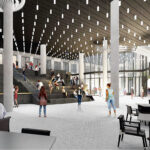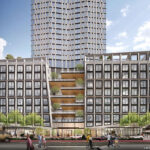With the proposed framework for rezoning San Francisco’s 84-acre Hub District, a.k.a. the “Market Octavia Plan Amendment,” closer to reality and the City finishing up construction on their new building at 1500 Mission, the plans for a 520-foot-tall tower to rise at 30 Van Ness are getting closer to reality as well.
As designed by Solomon Cordwell Buenz (SCB) for Lendlease, the proposed tower would now yield around 350 residential units (a mix of 34 studios, 4 junior one-bedrooms, 77 one-bedrooms, 167 twos and 66 threes), which is down from over 600 smaller units as originally envisioned, with nearly 230,000 square feet of podium office space, 7,000 square feet of ground floor retail, a basement garage for 153 cars and 456 bikes, and an outdoor POPOS and enclosed “multipurpose space” at the corner of Van Ness and Market.
We’ll keep you posted and plugged-in.






Nice! And best of all it will cover up Fox Plaza
It sucks that we lost the Fox Theater, but the Fox Plaza is a good and important building. The architecture is unique in the area (and in the high rises in the city), and – along with the AAA building – there’s a good argument to be made that without the Fox Plaza, we wouldn’t be in a position to get the Hub zoning.
And the architecture is actually pretty cool. You know, SF has a lot of near universally maligned buildings that future generations will appreciate a lot. Think about the widespread hatred people have for several of the very best buildings in all the city: Embarcadero Center, the Eichler tower, the Morphosis federal building, the Marriott Marquis.
Fox Plaza’s time will come as well.
It reminds me of the Hilton next to Transamerica Pyramid. I just can’t bring myself to like it.
As a lifelong resident of San Francisco, I’ve heard lots of adjectives used to describe Fox Plaza; but this is the first time I’ve heard words like “good” and “unique.” You are right that it set a precedent for greater height and density in this area, but the precedent has always been perceived as a negative one.
For a certain class/ generation of San Franciscans who cut their political teeth in the land use battles of the 60’s and 70’s Fox Plaza has served as posterchild for all the reasons why “density” is a 4 letter word in the NIMBY vocabulary.
I want to see San Francisco embrace greater height and density across the City. But believe me, you are not going to get very far if you point to Fox Plaza as an example of the kind of change that you want to see in their neighborhood.
“Unique” is an adjective one uses because it’s hard to dispute: each building is unique…as is every other. That having been said, it was an early and still un…usual example of a multi-use structure (Residential, office and – to a limited extent – retail). I think the loss was felt more as an architectural one than a planning shortfall.
are you a member of the BORG Collective? That is the only way anyone could mention the Seventh Street Sarcophagus as “good”, if they have been ASSIMILATED. All that building needs to complete its horror is some kind of laser beam emitted from the tower.
Not every controversial building ages well and is loved in the future. And your credibility is further destroyed by mentioning the gaudy Marriott as some kind of good. Maybe not a BORG? Maybe a Trump interior decorator?
The Fox Theater closed in 1963. 1963!! Are we seriously still mourning its loss?
Yes. I am not sure why something being lost a long time ago makes the loss any less significant? No one is out in the streets wearing burlap and down on their knees wailing, they are simply correctly pointing out it was a terrible mistake to allow the Fox Theater to be demolished, especially considering the ugly and now somewhat dilapidated piece of crap that replaced it. If the location had received a beautiful new building, which could have included an attractive and well-designed high-rise, there might be less lamenting over what was lost.
Why was it a mistake to “allow” it to be demolished? Per here: it was unsuccessful commercially. It closed down because it wasn’t popular anymore. Would it have made more sense to require it to exist, empty of paying customers?
You’re not the first person to ask “why”: the 04/02/63 ‘Examiner’ quotes Van Johnson thusly (in connection with the ongoing demolition): “Gee whiz why? I thought this was a town where they didn’t tear down things to put up modern abortions.”
And that, I think, sums up the sentiment: not disappointment at replacement ‘per se’ – the Ex had earlier that year described it as “an obsolete, lower density commercial building”, but disappointment at the specifics.
It was the Fox’ misfortune to have existed in a town with a surfeit of performing venues: had SF not had the Opera House, it might have gone the same route as the Paramount in Oakland (or any of a number of other rehabs around the country).
The Fox Plaza should be respected for the fact that it is one of the first buildings with apartments & office space, something that should have been more prevalent.
My observation of why the Fox Plaza is so hated is because it replaced the Fox Theater which is not the fault of the developer. I think people have been conditioned to hate the building for that reason but do not realize it.
My 50 square view is wonderful & have enjoyed it for 49 years!
I think there are very small group of people who even know about the Fox theater. Actually, one of the main reasons, aside from its visual brutalism, is the fact that due to the total insensitiveness and naiveté of the designers and developers it pretty much singlehandedly created a major hazardous wind-tunnel on Market Street and brought us the very strict wind controls we now have in the Planning Code that have become a bane and obstacle to create density in this part of the city. That building creates a huge western facing wall that funnels the wind coming from the west straight down to the street level and around the building. Had the designers actually thought about the environmental conditions of the site and valued public spaces that are comfortable and safe to be, they would have oriented and shaped the building very differently. That, and the ground floor is unnecessary inward facing, totally anti-urban and inhumane, creating a huge dead zone on Market Street.
Agree – the theater loss was tragic, but it’s the street presence that is horrible today. Blank face, no activity, and insane winds. Really disappointed the two story bank/starbucks buildings in its plaza didn’t get redeveloped to hide more of Fox. Also crazy the city just hasn’t forced the building to remedy the wind problem, especially with its recent remodel!
I most whole heartedly concur with @Hunter and @intheknow. It was Fox Plaza and slew of other horribly designed high-rise buildings in the Mid Market & Union Square areas that helped inspire a fierce backlash against “Manhattanization” (i.e. height & density). It’s true that perceptions have softened for a few high-rises from this era (e.g. the Transamerica Pyramid); but these buildings tend to be located closer to the Financial District core and are more of an exception than the norm.
It’s hard to imagine how buildings like Fox Plaza, 1455 Market, The Union Square Hilton, 1275 Market, (I can name many more) will ever be perceived as anything other than gigantic eyesores. These buildings set horrible precedents for growing upwards instead of outwards, and inspired a NIMBY backlash that we still have to contend with.
If you want to convince someone (particularly if they have been in the City for a long time) why we should relax height and density restrictions in San Francisco, buildings like Fox Plaza are terrible examples to use.
John L, wasn’t 1455 Market mainly built to be a datacenter? If so, the squat pedestal makes sense (especially back then). The office tower was probably ancillary?
If anyone would like to know more about the Fox Theatre, this link to it’s CinemaTreasures page will yield 4 pages of photos and an overview of the theatre as well as comments about it’s history from CT members.
It is an ugly building, and mixed-use buildings were not a new concept when it was built. Though, it is an early example in SF of a modern mixed-use high-rise. I have had about four friends who lived there, and aside from the view, none of them enjoyed living in it. Each of one of them was over-the-moon happy when they were able to afford to move to better housing in the city. It is rent-controlled housing, and of course, that is needed, but that doesn’t make it a successful or pretty building.
That said, to each his own, and I am glad you are happy there.
It’s hard to see this going forward anytime soon. The future for new condos in SF is in doubt. Certainly the medium term future. No one knows for sure how residential real estate prices will fare in SF. Zillow projected a small 2% or 3% decline. That may be too optimistic as, for condos, prices already were in decline. And population had peaked prior to the pandemic. It will surely fall now as the hotel/hospitality and small retail/restaurant business takes a big hit. Some say tourism won’t return until 2023. These jobs are low paying and many of these workers will be forced to exit SF and the Bay Area for financial reasons. The demand for these types of units will fall-off and especially as higher paying jobs are being lost in SF with Uber laying off a big chunk of its workforce, Airbnb also. Not to mention the exodus of start-up tech companies from SF which has picked up with the pandemic.
Negative interest rates = great time to take out construction loans
Dave, you’ve been insisting on this same line for years, and it has yet to manifest itself in any way resembling your claims. At some point you have to realize that crying wolf stopped working a long time ago. How about some non-cherrypicked evidence for this exodus you’re talking about? Or are we just going to ignore that only a tiny percentage of tech companies and jobs in the area moved out (rather than just eliminating the jobs)?
I am founder in a VC backed start up in downtown SF. We plan to continue to grow here. So this is a great new construction plan for growth.
That’s great. That still doesn’t change the fact that Van Ness and Market is the intersection of nuthouse and despair. No clue why anyone would want to live here when the rest of the city exists. Literally any other place in SF is more desirable than this location.
I live a block away from this corner. It has its major issues, but the neighborhood is highly walkable, close to tech company commuter shuttles, and directly above every single Muni metro line plus two major north/south Muni bus lines.
If a neighborhood’s greatest selling point is the ability to get to other areas, that’s leads to a pretty bad day to day life. It’s just temp housing for flyover state relos trying to find a better area to live in.
And no I wouldn’t live in Noe either.
Provide evidence for this ludicrous claim, scurvy. You’re just projecting your subjective opinion onto a place without any basis in actual fact. “I don’t like it personally” =/= “it’s a bad place occupied only by ignorant flyovers”.
Hardly ludicrous. I’ve often thought the same thing when people stress the transit friendliness of a neighborhood. If the best thing about a neighborhood is the ability to leave it…
You are incredibly sheltered if you think that “literally” any other place in SF is more desirable.
There is life outside Noe Valley.
In addition to layoffs, Uber was hinting last week that it could move headquarters to Texas, and the website it set up for its long-planned move to Mission Bay is now a dead link.
This is fabulous!!!!
Wait!!!! You mean the world is not going to end?!?
Awesome!!
With a 2-3 year prep and construction timeline, this project will come online just as we are coming out of this pandemic with a vaccine in hand. All the negative job growth in the Nation at this time will start to rebound in the 3-4 year time frame. This is a solid project and will have no problem filling up .
An excellent point. Now is not a good time to sell, but it is a good time to start building. And with the slowing economy, construction costs might be lower.
Financing too.
Sure, but who says those jobs are coming back to SF?
Expect midtier cities to get the rebound as lower costs and viability of tempting in takes primary hold.
Exactly. Both Juul and Credit Karma announced last week they are abandoning San Francisco. They are also reducing force. I could see Uber abandoning its high priced SF digs – they are already cutting workers. The economic crisis will force a lot of smaller tech companies to do the same. No more high priced office space or overpaid workers. SF’s tech workforce could take a significant hit in the near future and it is that workforce which is generally the target group for these pricey new condos.
Your really throwing out the Juul card? A company that has need ostracized through the US. Shows how out of touch you are. Uber is part ownership with the Warriors in their new headquarters in Mission Bay. They abandoned their Uptown Station in Oakland a few years back. In the near future yes but in the long term future NO. As pointed out above, this new project could pencil out with lower construction costs and market will decided the price of the units.
Dude, you continue your string of half-baked, ill-formed analysis. Credit Karma is being acquired by Intuit. It is not abandoning SF. Juul’s R&D and marketing units are remaining in SF (good riddance, I say). The cratering of demand, especially in travel/leisure tech is a black swan event These events do have long term impact with unknown outcomes. The first dotcom bust in SF created the foundation of the second ‘dotcom’ boom. The building proposed is for apartments, not condos.
The building proposed is for apartments, not condos.
While originally envisioned as Rentals versus Ownership units, the project application left the door open for either use.
Every new project in SF is condo-mapped and developers will always keep their options open. But I think the economics actually favor rental apartments over condo sales at the moment. In part, that’s why we are seeing many new projects go that route.
Expect based on what evidence? The overwhelming body of evidence shows that when jobs relocate out of the Bay Area, they go to other established major metro areas (yes, places like Austin, Charlotte, and the Research Triangle are established). These jobs don’t end up in Omaha or Albuquerque or Louisville.
Didn’t the mid-Market tax cuts expire, too? That makes the immediate area less attractive for hiring.
Hmmmm. COVID is a Coronaviurus just like the common cold. Which was of course eliminated decades ago by an effective vaccine. As was AIDS, thankfully. The new vaccines for that scourge have saved hundreds of thousands of lives. And the flu. Which has a vaccine, which has stopped almost all deaths from that scourge of humanity.
Wait….what…the Panglossian view that we can solve every problem through SCIENCE!!!!111! is NOT true.? An ever-evolving COVID virus won’t be stopped that easily (as were not the above listed diseases) Pshaw.
Dave, you mentioned population decline as a factor. Any thoughts on how the expected decrease in the population of japan (from 127 million today to 107 million by 2040) will influence real estate prices in Japan? That’s a huge projected population decrease
Japan Is [already] Giving Away 8 Million Abandoned Houses
And now back to the project, or at very least the country and city, at hand…
Indeed. The only places in the world with population decline are those where (a) there is major rural to urban migration, (b) countries with birth rates that aren’t replacing or increasing the population, (c) natural or manmade physical disasters or conditions (eg sea level rise, hurricanes, nuclear meltdown, etc), or (d) shifts away from industrial ecnomies/major technological realignment.
Japan is mostly a case of birth rates (though undoubtedly they, like other developed countries, also have depopulating rural areas). China, I believe has an issue with both birth rates and rural to urban at this point, since they were a bit too successful with their one child policy for decades. As far as I know, the only places in the US that are steadily depopulating across economic cycles (rather than minor blips due to temporary economic conditions) are rural areas and small towns far removed from major metropolitan areas. If the US dramatically caps immigration, it is possible that our birth rate could cause population stagnation or decline like many other countries. We are past the mass suburbanization in the US that depopulated city centers over multiple decades.
Predominant evidence suggests that the recent out-migration trends and population growth pause in the bay area is due purely to housing costs. If the current crisis causes housing costs to reset a bit, that suggests that the forces pushing people out would subside or reverse, and the cycle of the past ten+ years will repeat, with companies growing and population growing until the housing crisis reaching past tipping again. Rinse and repeat. Unless of course the current crisis does not cause construction costs to go down.
That’s not true. There has been an almost decade long slow steady drop in bay area migration. Ending with the adult population of SF actually declining even before COVID.
NYC’s population had declined before COVID. And since people have been out migrating from the BA for years it would take more than a dip in home prices to lure them back.
The allure of cites comes and goes. And it was already slipping pre COVID: “The country’s three largest metropolitan areas, New York, Los Angeles and Chicago, all lost population in the past several years…”
The whole “end of cities” narrative during this crisis has been particularly asinine, ahistorical, and counterfactual. None of the really terrible example metros these pieces focus on has even seen precipitous population declines. They’ve been statistically flat with some very small declines as a percentage of peak population. There’s way too much thinking dedicated to treating them like Detroit or Cleveland when they aren’t even in the same galaxy.
“It’s so crowded no one goes there anymore.”
Win some, lose some: parts of the Bay Area ARE losing people…SF – the county and city – is not. Of course as has been pointed out, the latter is growing mostly due to births/over deaths, and babies don’t buy houses .. right now any way, as that part of their life-cycle is several decades away (and the Juul using part at least one).
[Editor’s Note: We’ll have the break down, in terms of net migration and actual drivers,
later todaytomorrowMonday. As always, the devil is in the details.]This is a wonderful addition to Van Ness and the Hub District. Great Van Ness facade on such a prominent corner in the near future. Hoping this gets approval and some easing of restrictions so it pencils out. Timing will be critical for sure.
Prominent for what? Bus lines and the open-air asylum? This is merely relocation housing for wet behind the ears college grads from flyover states. What are you expecting the immediate area to turn into? Paseo del Prado?
You really seem to have a disdain for local history and the well-documented sociological aspects of how neighborhoods evolve.
I work right there. I know exactly how it will devolve.
Considering the sheer amount of traffic at this intersection and central location, this is already an extremely prominent yet under-developed corner in the city. You seem uninformed of the neighborhood you work in. With the development happening here, the Bart station, the muni station, the F line, the BRT stops, and the proximity to Hayes Valley, the importance of this corner will only increase. As location goes, it already is, but once it is fully developed it will certainly be more pedestrian friendly and lively. Not sure why someone coming to the city for the first time would be viewed as a lower value than you? Fly over states? Truly an obnoxious and pathetic comment.
Really not a fan of most of SCB comes up with but I’ll take it if we can add some life to that corner. Stoked to at least see any rendering at all, actually / finally.
Looks like the architect is making a subtle reference to Sutro Tower on the corner elevation.
I was just gonna say that, too. I like it!
Well we’re closer to 2093 each day, too, but it’s still a long way off: this post seems rather light on actual details of progress – is the financing still in place? any space pre-sold/leased?
I’ll forgive however: like ‘Joe’ I’m just crazy about that Sutro-esque corner – has a real Art Deco feel to it –
and breaks from the tedium of bad-news are welcome…however s-t-r-e-t-c-h-e-d.
I’ve mentioned this before, but I’ll do it again: one of the best things a project like this could do for the city is to incorporate the subway entrance into the building, freeing up public space on the sidewalk and reducing public costs (a lot easier to close a gate than to build/maintain an entire structure like they’re doing up Market).
Perhaps the city could have them do this in lieu of POPOS space or some other requirement.
It could even have some underground retail space connected to the subway access, making it a better public space. Good spot for supermarkets, corner stores, services, and other small businesses catering to commuters.
Well said Alai. It would be nice as a consideration for all the relevant Hub developments (including, e.g. the 10 S Van Ness development), in lieu of POPOS if necessary. Far more public benefit.
That canopy over the NE corner of Market/Van Ness evokes thoughts of what was to have been across the street at the Build’s proposed One Oak project.
Glad to see 66 three bedrooms! We are families!
a stack of large balconies facing directly into the wind… would be much better placed on the Market St side.
The wind will still wrap around the building. Just stand at the corner of Fell and Van Ness to experience it.
Lendlease has put scaffolding up around the building recently, I guess they’re getting ready to demolish it.
UPDATE: 520-Foot-Tall Tower Is About to Rise
The fox just needs a reskinning, has been tinkered with but not done fully to make it a worthy rehab. had a studio there prior for $987 per month, now who knows what they cost.. ?